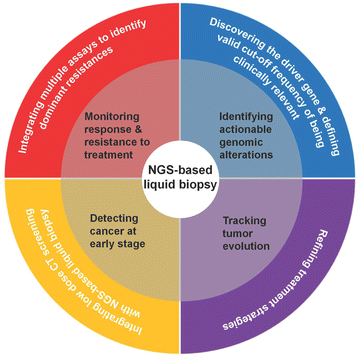The emerging roles of NGS-based liquid biopsy in non-small cell lung cancer
- PMID: 29061113
- PMCID: PMC5654124
- DOI: 10.1186/s13045-017-0536-6
The emerging roles of NGS-based liquid biopsy in non-small cell lung cancer
Abstract
The treatment paradigm of non-small cell lung cancer (NSCLC) has evolved into oncogene-directed precision medicine. Identifying actionable genomic alterations is the initial step towards precision medicine. An important scientific progress in molecular profiling of NSCLC over the past decade is the shift from the traditional piecemeal fashion to massively parallel sequencing with the use of next-generation sequencing (NGS). Another technical advance is the development of liquid biopsy with great potential in providing a dynamic and comprehensive genomic profiling of NSCLC in a minimally invasive manner. The integration of NGS with liquid biopsy has been demonstrated to play emerging roles in genomic profiling of NSCLC by increasing evidences. This review summarized the potential applications of NGS-based liquid biopsy in the diagnosis and treatment of NSCLC including identifying actionable genomic alterations, tracking spatiotemporal tumor evolution, dynamically monitoring response and resistance to targeted therapies, and diagnostic value in early-stage NSCLC, and discussed emerging challenges to overcome in order to facilitate clinical translation in future.
Keywords: Liquid biopsy; Next-generation sequencing; ctDNA.
Conflict of interest statement
Ethics approval and consent to participate
This is not applicable for this review.
Consent for publication
This is not applicable for this review.
Competing interests
The authors declare that they have no competing interests.
Publisher’s Note
Springer Nature remains neutral with regard to jurisdictional claims in published maps and institutional affiliations.
Figures
References
Publication types
MeSH terms
LinkOut - more resources
Full Text Sources
Other Literature Sources
Medical
Miscellaneous



